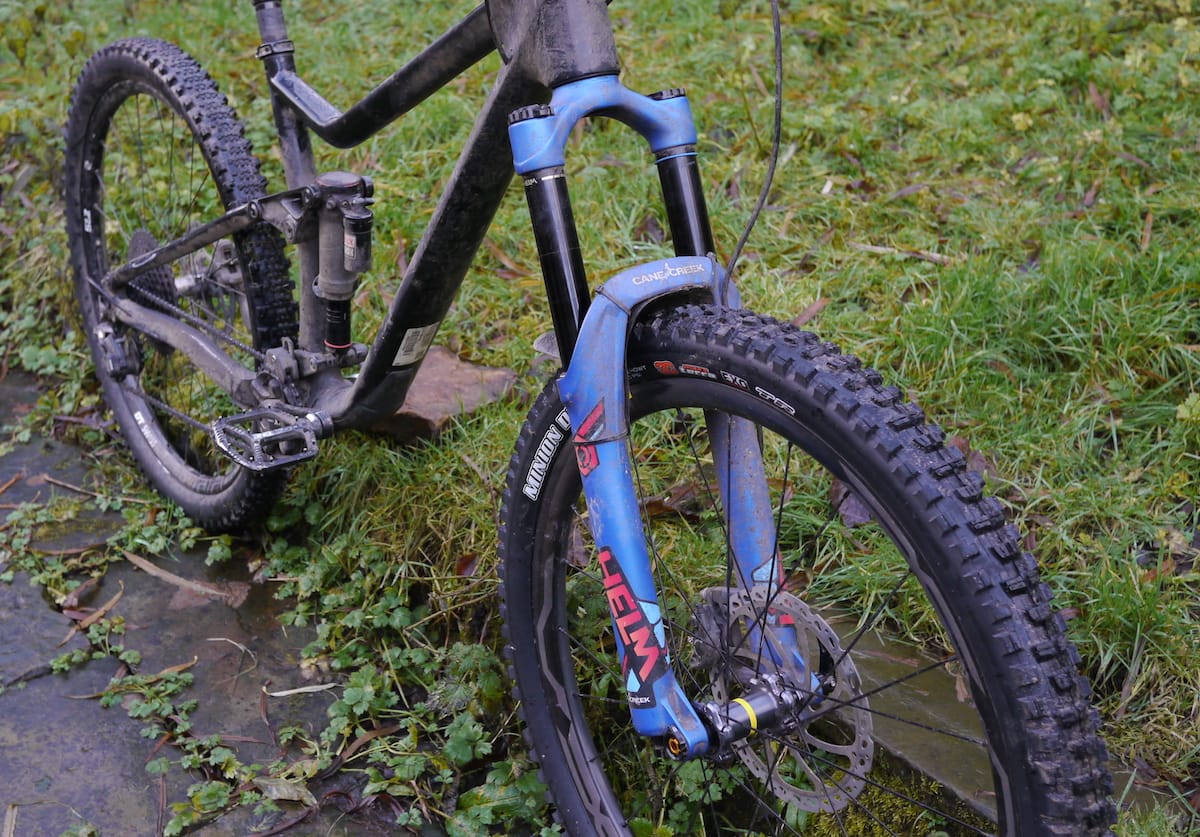Cane Creek is a new entrant into the suspension fork market, having released its Helm fork less than a year ago. We got a very spangly Limited Edition blue fork to test and gave it to our resident tech nerd, David Hayward, who has been testing it aboard a Merida One Sixty.
The Helm was something of a surprise when we spotted it, just before it was announced, on Cane Creek’s website. After more than a decade since it made the Double Barrel shock, Cane Creek has finally taken the leap into making its own forks. We’ve been testing one of the Launch Air forks, limited to 300 in blue. If you want one yourself, at present it’ll be black, or a sumptious black and gold.


The Helm is built around 35mm stanchions, with travel adjustment from 140 to 170mm, so is aimed solidly at trail and enduro bikes. Externally it has rebound, high and low speed compression adjustments, plus a button to pressurise the negative air chamber (more on that in a bit). Internally, it has air volume adjustment by repositioning a static piston, and travel adjustment via spacers.
Air volume adjustment is a simple affair, somewhat like putting spacers in a Rockshox, Fox or DT Swiss fork. Unlike those, the Helm operates with a piston on a notched shaft though. Depressurise the fork, remove the top nut and air volume shaft with a spanner, then simply reposition and reassemble. One difference this makes compared to plastic spacers is that you can’t file a spacer down to a half or quarter, but the eight possible positions seem roughly equivalent to half spacers in other forks.


The Guts
Travel is internally adjustable in 10mm increments, and all that’s required to do that is a few common tools, plus plastic spacers that pop onto the shaft inside the right hand fork leg. Doing this is a more complicated procedure than air volume adjustment, but it’s much simpler than many other forks, and the process really shows the design thinking Cane Creek has put into the Helm.
Firstly, the only parts that need changing are the number of spacers clipped onto the shaft. No cartridge or shaft changes are required. Secondly, the Helm is designed to minimise the number of tools required to get into and reassemble the fork. Just two spanners (13 and 18mm), a mallet, plus one pokey thing (to let the air out) will get the travel adjust done, and the air volume adjustment only needs a 30mm spanner or socket. Every other step on these jobs can be done with your fingers.


The internals are readily comprehensible and, compared to some other forks I’ve opened only to find all sorts of tiny ball bearings and springs, very easy to work on. Finally, one very convenient part of the process is that, when you remove the uppers with the fork face down on a flat surface, the lowers are designed to retain all of their oil, so you don’t even need to drain, then refill them.
Cane Creek’s designers seem to have done their utmost to make the internals accessible and quickly understandable for home mechanics, documenting everything with good video tutorials. This fork came factory set to 160mm; I removed a spacer to bump it up to 170mm, then put it on a Merida One-Sixty.
Setting Up
Basic setup is a tad more involved than some forks, as the Helm has a negative air chamber to reduce stiction, but it doesn’t automatically equalise when you pump up the positive chamber or cycle the fork. To equalise them, you need to pressurise the positive chamber with a shock pump, then manually push a button on the bottom of the left fork leg. This also opens up more tuning options for you by enabling the two chambers to run at slightly different pressures, for instance making the suspension more active by running higher pressure in the negative chamber.

If you pressurise the fork and forget to equalise the negative chamber at all, you’ll quickly notice a very harsh top out knock. If you accidentally equalise with the fork under any load, even just having the weight of your bike on it, you might also temporarily lose travel, as happened to me during some last minute pub ride fettling. Correcting this takes seconds, simply pulling on the fork lowers while holding the equalisation button down.
Finally on this, I’d like to mention the axle system. Thanks to patents, every manufacturer seems to have their own thru-axle and some of them are positively byzantine. Not so with Cane Creek’s 15mm D-Loc system. Everything is very clearly marked and goes together in an affirmative manner. The axle has a specific orientation, helpfully etched onto it, plus threaded tension adjustment at the lever if you need it. A receiver mounted on the non-lever leg of the fork flips to lock the axle in place, then the lever tightens a cam to snug it all down. With lever and receiver unlocked, the axle slides straight in and out, no threading. D-Loc is quick to use, simple to understand, and has no fiddly bits that can fall off in car parks. It’s my new favourite axle system.


The Ride And Tuning
Cane Creek recommends roughly 1 PSI per kilogram of rider weight (including gear) before equalising the chambers, and I found this was a good starting point for me in terms of comfort and small bump compliance. With other fork manufacturers, I tend to get similar feel by running 10 – 15 PSI lower than their weight charts specify. At 75Kg with kit I’m towards the lighter end of the scale for most bikes in my size, and accordingly tend to run suspension quite soft.
It took a while with the Helm to feel like I was really utilising it though. Rather than make its own version of a competitor’s fork, Cane Creek has designed something that doesn’t mimic any other fork I’m used to. Assumptions I had from years of more commonly seen forks didn’t quite carry over, but that wasn’t a bad thing.


Firstly, compression adjustments. On many other forks these have a wide, cartoony range from super soft to almost locked out. On the Helm, they really are just for fine tuning performance, and the low speed compression dial doesn’t function anything like a lockout on climbs. Getting used to this meant my climbing smoothness improved, but if you really want a lockout for optimal fire road climbing, these might not be for you.
I also left the Helm at its default maximum air volume, because with longer forks I generally don’t need volume spacers to make things progressive enough, and sometimes even then struggle to use all the travel.
At average bimble velocities and with Cane Creek’s recommended maximum of 25% sag, I was using about 70% travel on most rides. A week in I dropped the pressure around 15 PSI to try to get them to full travel, and a sudden mid-ride switch to steeper terrain quickly revealed I’d let too much air out. What I then discovered was that, with my previous setup, I just needed to take the forks (back) to the top of something steep and rocky then point them down it. Fast. As soon as I went quickly, I was regularly using all 170mm without feeling any harsh or sudden bottom outs. If you’re heavier than me you might need to change the air volume to mimic this.

After dialling this in, all the other adjustments quickly fell into place for me and the fork started to make a lot of sense. After a few more tests, I filled it to 75 PSI, equalised the negative chamber, then let the positive chamber down to 69 PSI. This gave very good small bump compliance, plus enough support in the mid-stroke, followed by enough progression to soak up the occasional bigger hit or drop off. I did briefly try running the positive chamber even lower, but at that point found it packed down into the mid-stroke too much.
Trying to mimic your settings from another fork brand with the Helm doesn’t work, because it gives you more to play with than just volume spacing and air pressure. The two chamber design gives some subtly different results, and they seem to be aiming for a different portion of the market. I wouldn’t say the Helm isn’t for beginners, but unlike with the kind of forks that are stock on a massive range of bikes, with these you definitely benefit from having a little suspension knowledge and enough experience to really know your preferences.

After refining settings, whenever I slowed right down the Helm felt a bit… muzzled. Bored, even. Through months of testing, more so than any other fork I’ve ridden, the Helm rewarded me most for charging harder, often encouraging me outside of my comfort zone. If you’re looking for absolute cushy slow speed performance, I wouldn’t say the Helm will disappoint necessarily, I just don’t think this fork is aimed at you. If you want all of the travel, you have to work for it more than with some other forks. To me, the Helm feels like it was made for people who are racing or trying to hit their trails harder, because it really does excel when soaking up technical riding at speed.
Indicative of this characteristic, I ended up leaving the compression dials wide open most of the time. It didn’t seem that necessary after setup, as the Helm’s capability and comfort came from earlier setup steps. Sure, you can get more support by increasing the compression damping, but I found it tends to make the fork feel too harsh and reduce small-bump sensitivity.

Over the months, I really came to value the Helm’s consistent behaviour and predictability, more than I would a theoretical dial to firm it up on climbs. Ultimately, the Helm gives you more to think about during setup, but less to think about when riding.
Overall
This is well designed, with relatively simple internals and reduced tool requirements making it a pleasure to work on for home mechanics. I wouldn’t say this fork is for advanced riders only, but it’s definitely for people who like a lot of tune-ability and are careful enough to get setup right. The Helm is a fine fork, but to get the most out of it, you’ve got to go fast.







This is manner from heaven for those fat trail warrior’s who will love to advise the pub that their badly set up fork ‘is not for beginners’. You could then play bingo on the number of times they will use the phrase ‘dialled in’ ☺ I think this review guarantee’s sales for cane creek!
Use Censorship, Comments simply disappear …
Damn, that ninja edit on the review title leaves me looking weirder than normal 🙂
Tangs on the volume adjust piston/main piston look a touch ‘snappity’
Would love to try a pair